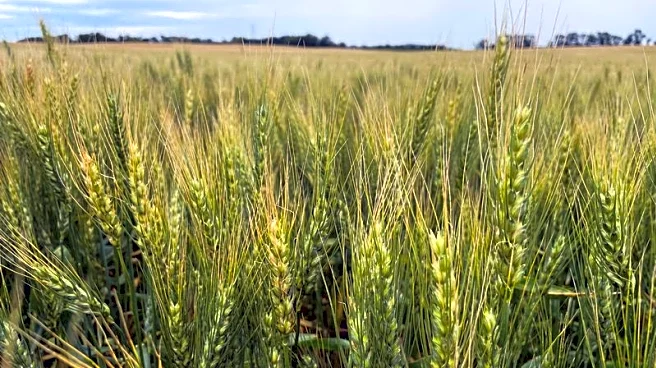By Julie Ingwersen and Karl Plume
CHICAGO (Reuters) -In a head-to-head contest in a small corner of agricultural futures markets, a legacy spring wheat contract that has traded for more than 140 years is fending off a challenge from a competing contract launched this spring by CME Group, the world's largest futures exchange.
Spring wheat, grown in the northern Plains of the U.S. and Canada, is favored for bagels and frozen dough. The contract was introduced in 1883 on the Minneapolis Grain Exchange
and has long set the price for premium-quality wheat used by North American millers and exported around the world.
Compared to other commodities, trade in spring wheat contracts is relatively modest. But it is among the only major agricultural commodity derivatives not dominated by CME Group, which in recent decades has expanded from its 19th-century origins as the Chicago Mercantile Exchange into a $99 billion behemoth with acquisitions including the Chicago Board of Trade and Kansas City Board of Trade. Now, nearly 2 million contracts are traded daily for corn, soybeans, winter wheat and livestock.
But CME's much smaller rival, Miami International Holdings, or MIAX, which bought the independent Minneapolis exchange in 2020 and moved it off of CME's electronic trading platform this summer, is winning the battle in spring wheat.
"It's David versus Goliath," said Joe Nussmeier, a broker with Frontier Futures.
Earlier this summer, CME’s spring wheat futures, saw hefty daily trading volumes of tens of thousands of contracts. Those volumes have faded to a few dozen a day, according to CME data. It also shows that open interest, which reflects the number of active contracts held by traders, has plummeted from a peak of nearly 2,100 contracts to around 600.
Large grain handlers and millers including CHS, Archer-Daniels-Midland and Cargill's joint venture Ardent Mills, who represent the bulk of commercial trade in spring wheat, are sticking with MIAX.
Traders said that most of the CME's early volume bump came from "market makers," or traders given an incentive by CME to trade the contract to boost market liquidity and facilitate trading for others. But those traders do not often take longer-term positions like commercial traders such as grain millers and elevators who use futures to hedge against the risk of owning large inventories of grain.
"It does not feel like there's any commercial participation, and what the product needs to thrive is a commercially backed hedger, whether it be an end user or a grain elevator," said Nussmeier.
CHS and ADM declined to comment. Ardent Mills did not immediately reply to requests for comment.
LEGACY CONTRACT
MIAX shares jumped 38% last Thursday, the day of its initial public offering on the New York Stock Exchange, valuing the exchange operator at about $2.5 billion.
CME Group's new spring wheat contract is a near look-alike in terms of structure, and both were traded electronically on CME's Globex trading platform until June 30, when MIAX debuted its Onyx trading platform.
Despite the new competition, trading in MIAX Minneapolis wheat futures has been steady at around 7,000 to 14,000 contracts per day this month after falling 31% in July, a drop traders said was due largely to technical problems associated with the shift to a new trading platform. Open interest has held around 60,000 to 70,000 contracts, close to historical levels.
Cash markets are also backing MIAX as bids for spring wheat posted by grain elevators across the northern Plains largely remain tied to its contract, not CME's.
"The legacy MIAX contract is still the favored contract," said Jeffrey McPike, a U.S. analyst with brokerage WASEDA Commodities.
In July, three CME employees traveled to Fargo, North Dakota, to promote the new contract among a group of some 50 millers and traders gathered for Wheat Quality Council's annual spring wheat crop tour.
CME-branded swag and a barbecue brisket dinner did not translate to more trade.
John Ricci, CME's global head of agriculture products, said the exchange would give its spring wheat contract "time to build."
(Reporting by Julie Ingwersen in Chicago and Karl Plume in Fargo, North Dakota. Editing by Emily Schmall and David Gregorio)












